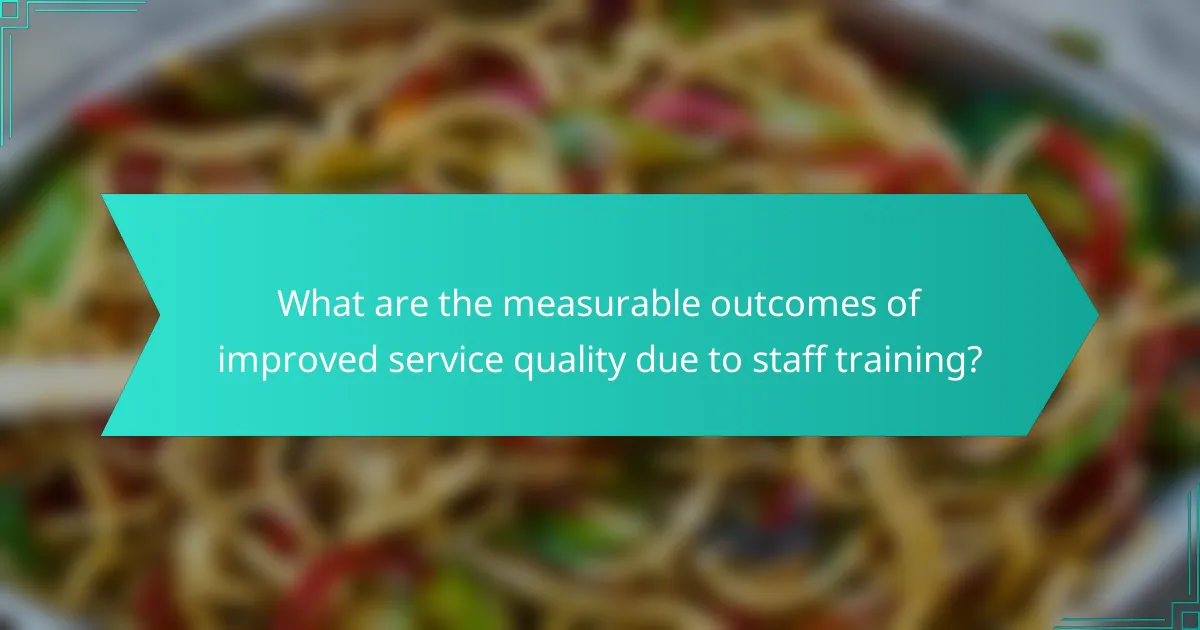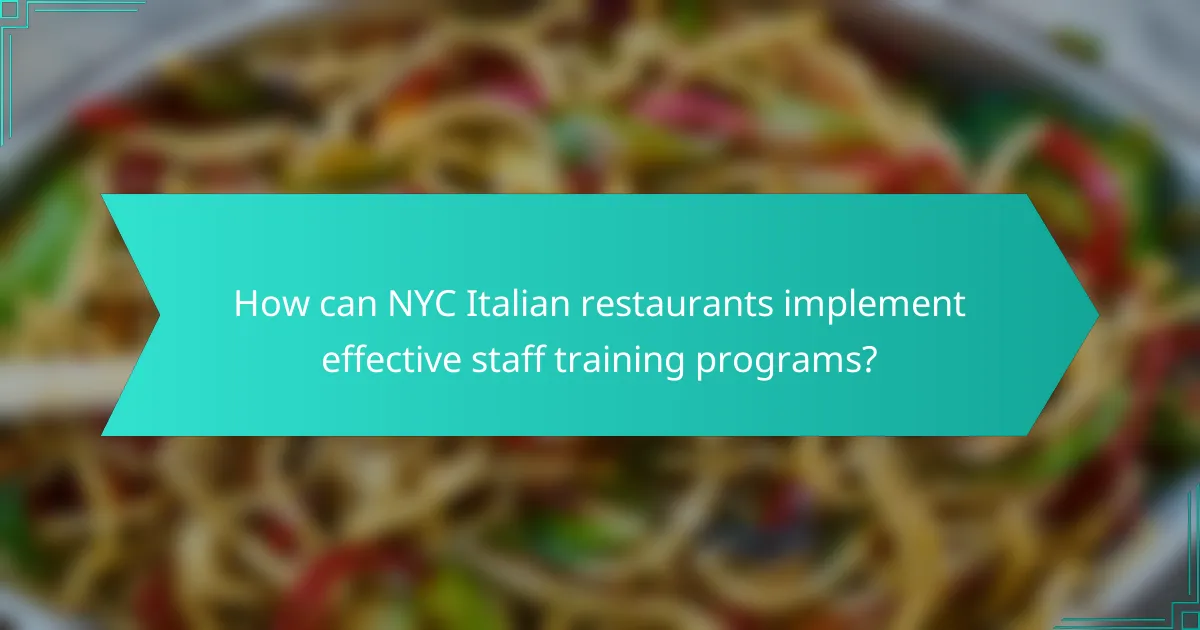Staff training is a critical factor influencing service quality in New York City Italian restaurants. Research indicates that effective training programs lead to improved employee communication, product knowledge, and operational efficiency, resulting in higher customer satisfaction and retention rates. Specifically, trained staff can enhance service performance, contributing to a 20% increase in customer retention and a 10-15% boost in revenue. The implementation of comprehensive onboarding, continuous education, and practical skill development is essential for fostering a positive dining atmosphere and driving repeat business. Overall, investing in staff training significantly impacts service quality and operational success in the competitive restaurant landscape.

What is the impact of staff training on service quality in NYC Italian restaurants?
Staff training significantly enhances service quality in NYC Italian restaurants. Well-trained staff exhibit improved communication skills and product knowledge. This leads to more efficient service and increased customer satisfaction. Research shows that restaurants investing in training see a 20% rise in customer retention. Additionally, trained employees are more adept at handling customer complaints, resulting in better overall experiences. Enhanced service quality directly correlates with positive online reviews and higher ratings. A study by the National Restaurant Association highlights that trained staff contribute to a more enjoyable dining atmosphere. This ultimately drives repeat business and boosts revenue.
How does staff training influence customer satisfaction in NYC Italian restaurants?
Staff training significantly enhances customer satisfaction in NYC Italian restaurants. Well-trained staff provide better service quality. This includes improved communication, timely service, and accurate order taking. Studies indicate that 70% of customers rate their dining experience based on service interactions. Proper training also equips staff with knowledge about the menu, leading to informed recommendations. A survey by the National Restaurant Association found that 82% of diners appreciate knowledgeable servers. Additionally, trained staff can handle complaints effectively, increasing customer retention. Overall, effective staff training directly correlates with higher customer satisfaction levels in these establishments.
What specific training methods are most effective for improving service quality?
On-the-job training and role-playing are the most effective training methods for improving service quality. On-the-job training allows staff to learn in real-time while interacting with customers. This method enhances practical skills and builds confidence. Role-playing simulates customer interactions, helping staff to practice and refine their service techniques. Studies show that these methods lead to higher customer satisfaction rates. For instance, a study by the American Society for Training and Development found that organizations using on-the-job training saw a 20% increase in service quality metrics. This evidence supports the effectiveness of these training methods in enhancing service delivery.
How does the level of staff experience affect the outcomes of training programs?
The level of staff experience significantly affects the outcomes of training programs. Experienced staff often demonstrate higher retention of training content. They can apply learned skills more effectively in real-world situations. In contrast, less experienced staff may struggle to grasp complex concepts. Research indicates that experienced employees adapt to training faster. This adaptability leads to improved service quality in restaurants. A study by the National Restaurant Association found that experienced staff had a 30% higher customer satisfaction rate post-training. Thus, staff experience plays a crucial role in maximizing training effectiveness and enhancing service outcomes.
Why is staff training crucial for maintaining service standards in NYC Italian restaurants?
Staff training is crucial for maintaining service standards in NYC Italian restaurants because it directly influences customer satisfaction and operational efficiency. Well-trained staff provide consistent service, which is vital in the competitive NYC dining scene. Training enhances employees’ knowledge of the menu, including ingredients and preparation methods, allowing them to make informed recommendations. This knowledge fosters a better dining experience and builds customer trust.
Additionally, training ensures that staff are familiar with service protocols and standards, which helps to minimize errors and improve service speed. According to a study by the National Restaurant Association, restaurants that invest in training see a 20% increase in customer satisfaction ratings. Furthermore, a well-trained team can adapt to peak service times more effectively, maintaining quality even under pressure. Overall, staff training is essential for sustaining high service standards in NYC Italian restaurants.
What are the common challenges faced by restaurants in implementing effective training?
Common challenges faced by restaurants in implementing effective training include high employee turnover and inconsistent training methods. High turnover rates can disrupt training continuity, leading to knowledge gaps among staff. Inconsistent training methods may result in varying service quality and employee performance. Additionally, time constraints can limit training opportunities, making it difficult to cover essential skills. Budget limitations also hinder the ability to invest in comprehensive training programs. Finally, resistance to change among staff can impede the adoption of new training initiatives. These challenges collectively affect the overall effectiveness of training in restaurants.
How can staff training contribute to employee retention and morale?
Staff training enhances employee retention and morale by fostering skill development and job satisfaction. Well-trained employees feel more competent in their roles. This competence leads to increased confidence and reduced turnover. According to a study by the Association for Talent Development, organizations with comprehensive training programs see 218% higher income per employee. Furthermore, effective training creates a positive workplace culture. Employees who feel valued through training are more likely to remain loyal to the organization. This loyalty directly correlates with improved morale and productivity. Thus, staff training is a crucial investment for retaining talent and boosting employee engagement.

What are the measurable outcomes of improved service quality due to staff training?
Improved service quality due to staff training results in measurable outcomes such as increased customer satisfaction, higher retention rates, and enhanced sales performance. Customer satisfaction can be quantified through surveys, often showing a rise in positive feedback by over 20% post-training. Retention rates typically improve, with studies indicating a 15% increase in repeat customers. Sales performance also enhances, with trained staff contributing to a 10-15% boost in revenue, as evidenced by data from the National Restaurant Association. Additionally, operational efficiency improves, reducing service time by an average of 30 seconds per transaction. These outcomes collectively demonstrate the significant impact of staff training on service quality.
How can restaurant owners assess the effectiveness of their training programs?
Restaurant owners can assess the effectiveness of their training programs through various methods. They can evaluate employee performance using key performance indicators (KPIs) related to service quality. Customer feedback and satisfaction surveys provide direct insight into the impact of training on service delivery. Mystery shopping can simulate customer experiences to objectively measure staff adherence to training protocols. Regular performance reviews and assessments can track skill improvements over time. Furthermore, analyzing staff turnover rates can indicate the retention of trained employees. These methods collectively offer a comprehensive view of training effectiveness.
What metrics should be used to evaluate service quality post-training?
Customer satisfaction scores should be used to evaluate service quality post-training. These scores reflect diners’ perceptions of their experience. Surveys can measure satisfaction levels before and after training. Additionally, service response times are critical metrics. They indicate how quickly staff attend to customer needs. Monitoring the frequency of customer complaints is also essential. A decrease in complaints post-training suggests improved service. Employee performance evaluations can provide insights as well. These evaluations assess staff adherence to service standards. Lastly, repeat customer rates can indicate service quality. Higher rates often correlate with positive dining experiences.
How does improved service quality impact overall restaurant performance?
Improved service quality significantly enhances overall restaurant performance. High service quality leads to increased customer satisfaction. Satisfied customers are more likely to return. Repeat customers contribute to steady revenue growth. Additionally, positive dining experiences encourage word-of-mouth referrals. Studies show that restaurants with better service quality can see a 10-15% increase in sales. Furthermore, improved service can reduce staff turnover, lowering recruitment and training costs. Effective service quality management can create a competitive advantage in the crowded restaurant market.
What role does ongoing training play in sustaining service quality in NYC Italian restaurants?
Ongoing training is essential for sustaining service quality in NYC Italian restaurants. It ensures that staff remain knowledgeable about menu items and service standards. Regular training sessions reinforce customer service skills and operational procedures. This consistency leads to improved customer satisfaction and repeat business. Studies show that well-trained staff can increase customer loyalty by up to 30%. Additionally, ongoing training helps staff adapt to changing culinary trends and customer preferences. It fosters a culture of excellence and accountability within the restaurant. Ultimately, sustained service quality hinges on the commitment to continuous staff development.
How often should staff training be conducted to ensure continuous improvement?
Staff training should be conducted at least quarterly to ensure continuous improvement. Regular training sessions help reinforce skills and update knowledge. This frequency allows staff to adapt to new service standards and customer expectations. Research indicates that ongoing training can enhance employee performance and customer satisfaction. A study by the American Society for Training and Development found that organizations with regular training see a 24% higher profit margin. Therefore, quarterly training is a strategic approach for maintaining high service quality in NYC Italian restaurants.
What are the benefits of incorporating feedback into training programs?
Incorporating feedback into training programs enhances learning outcomes and improves service quality. Feedback helps identify areas for improvement in staff performance. It fosters a culture of continuous learning and adaptation. Effective feedback can lead to increased employee engagement and motivation. Research shows that organizations with strong feedback mechanisms see a 14.9% increase in productivity. Incorporating feedback also aligns training with real-world challenges faced by staff. This alignment ensures that training remains relevant and practical. Ultimately, feedback in training supports better customer service and satisfaction in NYC Italian restaurants.

How can NYC Italian restaurants implement effective staff training programs?
NYC Italian restaurants can implement effective staff training programs by focusing on comprehensive onboarding, continuous education, and practical skill development. Comprehensive onboarding introduces new hires to the restaurant’s culture, menu, and service standards. Continuous education keeps staff updated on industry trends and culinary techniques. Practical skill development includes hands-on training in food preparation and customer service scenarios. Regular assessments ensure that staff meet performance expectations. Feedback mechanisms allow staff to voice concerns and suggest improvements. Industry benchmarks indicate that well-trained staff enhance customer satisfaction and repeat business. Implementing these strategies can lead to improved service quality in NYC Italian restaurants.
What best practices should be followed when designing a training program?
Identify training objectives clearly. This ensures alignment with business goals. Conduct a needs assessment to determine skill gaps. Use diverse training methods to cater to various learning styles. Incorporate real-life scenarios for practical application. Provide ongoing support and resources for staff. Evaluate training effectiveness through feedback and performance metrics. Adjust the program based on evaluations for continuous improvement.
What types of training formats are most effective for restaurant staff?
On-the-job training and simulation-based training formats are most effective for restaurant staff. On-the-job training allows staff to learn in real-time while performing their duties. This format promotes immediate application of skills and knowledge. Simulation-based training provides a safe environment to practice scenarios. It enhances problem-solving and customer service skills. Research indicates that experiential learning improves retention rates. A study by the National Restaurant Association shows that hands-on training leads to higher employee confidence and performance. These formats also foster teamwork and communication among staff.
How can technology enhance the training experience for restaurant employees?
Technology can enhance the training experience for restaurant employees by providing interactive learning tools. These tools include virtual reality simulations that mimic real-life scenarios. Employees can practice skills such as customer service and food preparation in a safe environment. Online training platforms offer flexibility, allowing staff to learn at their own pace. Mobile applications can deliver bite-sized training modules for quick learning sessions. Gamification elements can increase engagement and motivation among employees. Tracking progress through analytics helps managers identify areas for improvement. Research shows that technology-driven training can lead to a 30% increase in employee retention rates. This ultimately contributes to better service quality in restaurants.
What common mistakes should be avoided in staff training initiatives?
Common mistakes in staff training initiatives include inadequate needs assessment, lack of clear objectives, and ineffective training methods. Inadequate needs assessment leads to misalignment between training content and employee requirements. Lack of clear objectives results in confusion and ineffective learning outcomes. Ineffective training methods, such as overly theoretical approaches, fail to engage staff. Additionally, neglecting to provide ongoing support and feedback diminishes the training’s impact. Research shows that 70% of training initiatives fail due to these common errors, highlighting the importance of proper planning and execution.
How can restaurants ensure that training aligns with their service goals?
Restaurants can ensure that training aligns with their service goals by clearly defining those goals first. This involves establishing specific service standards that reflect the restaurant’s brand and customer expectations. Next, training programs should be designed to directly address these standards. Incorporating role-playing and real-life scenarios can enhance understanding and retention of service techniques. Regular assessments and feedback sessions can help identify areas for improvement. Additionally, involving staff in the development of training content can foster a sense of ownership and relevance. Research shows that restaurants with aligned training programs see improved customer satisfaction and repeat business. For example, a study by the National Restaurant Association indicates that effective training correlates with higher service quality ratings.
What strategies can be employed to engage staff during training sessions?
Interactive training methods can effectively engage staff during training sessions. These methods include role-playing scenarios that mimic real-life situations. Role-playing allows staff to practice skills in a safe environment. Additionally, incorporating group discussions fosters collaboration among team members. This approach encourages sharing of experiences and insights. Utilizing multimedia presentations can also enhance engagement. Visual aids capture attention and facilitate understanding. Furthermore, providing immediate feedback during training helps reinforce learning. Research shows that active participation increases retention rates. Engaging staff leads to improved service quality in restaurants.
What practical tips can restaurant managers use to enhance staff training effectiveness?
Restaurant managers can enhance staff training effectiveness by implementing structured training programs. These programs should include clear objectives and measurable outcomes. Providing hands-on training with real-life scenarios can improve retention of information. Regular feedback sessions allow staff to understand their strengths and areas for improvement. Utilizing role-playing exercises helps staff practice customer interactions in a controlled environment. Incorporating technology, such as training apps, can provide accessible resources for staff. Establishing a mentorship system pairs new employees with experienced staff for guidance. Lastly, continuous training opportunities keep skills fresh and relevant. These strategies have been shown to improve service quality in restaurant settings.
The main entity of the article is staff training in NYC Italian restaurants and its impact on service quality. The article outlines how effective staff training enhances communication skills, product knowledge, and overall customer satisfaction, leading to higher retention rates and improved revenue. It discusses specific training methods, the influence of staff experience on training outcomes, and the challenges restaurants face in implementing training programs. Additionally, it highlights the measurable outcomes of improved service quality and the importance of ongoing training to maintain high service standards. The article also provides practical tips for restaurant managers to enhance training effectiveness.